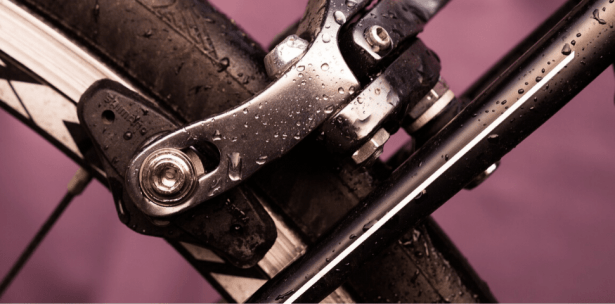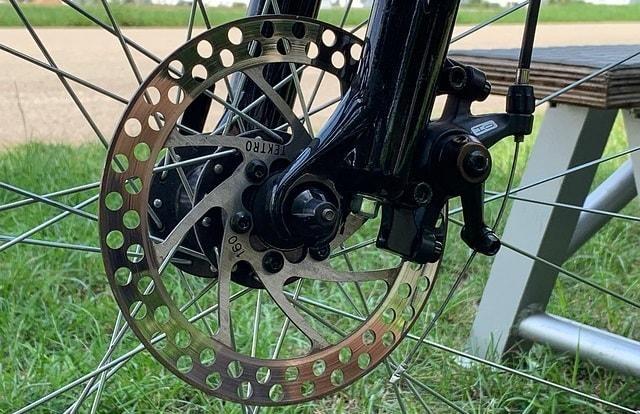There’s nothing more annoying than squeaking brakes, ruining the calm and serenity of a country ride or making a crowd of people stop and stare on an urban commute.
If you are suffering from noisy brakes, this article should help you find and fix the problem, and get back to riding your bike without the high pitched acoustics.
What causes squeaky brakes?
Squeaking brakes can occur for several reasons; usually to do with contamination, miss-alignment or not being bedded in. It can often be a sign of reduced brake performance and added wear, so it is important to have it fixed.
We’ll go through a few of the most common reasons and provide remedies for eradicating the noise on both rim and disc brakes.
Rim brakes

Credit: melkhagelslag via Pixabay
Dirt Contamination
As you apply brakes the blocks will wear down leaving rubber and metal residue. This can combine with other dirt and muck picked up from the road, and collect at the blocks.
This leaves a dirty braking surface, which can cause squeaking, poor braking and increased rim wear.
To fix this take the wheels out and inspect the brake blocks for dirt. Use a clean cloth or brush to remove most of the dirt.
Next, use a non-oil based degreaser or cleaning product and clean cloth to clean the brake blocks and clean all of the rims on both sides.
If you don’t have any specific product, distilled vinegar work quite well too. Put the wheel back on and flip brake up if a road calliper.
Grease/oil contamination
Another cause could be that grease or oil has contaminated the braking surface. It only takes a little bit to create ear-piercing notes.
Contamination can come from greasy fingers touching the rims/blocks or using an aerosol/spray too close and getting onto braking surfaces.
Again, to solve this take the wheel out and clean just the same as described for dirt contamination; non-oil based degreaser (or vinegar), clean cloth for the brake blocks and wipe all of the rims. Put the wheel back on and flip brake up if a road calliper.
Brake blocks not toed
Brakes make a lovely squeal if brake pads hit the rim flat. This is especially true of linear pull (V-brakes). To avoid this you need to toe your pads, which means adjusting so the front of the pad hits the rim first when the brake is applied.
Firstly, loosen one block pads and put in a brake toe tool (or a thin strip of card folded once over will work) at the back of the pad.
Next press the brake down and make sure it is pressing on the rim braking surface and tighten it up again. The card should mean the pad tightens up with a toe. Repeat for the other block/pad
Tried the above and still squeaking – Consider replacing
If you have tried all the above, but to no avail, it might be worth considering replacing the brakes. Low end brakes, especially linear v- brakes which have plastic arms, have a tendency to flex under braking.
If this is the case, upgrade the brakes with new brake callipers and blocks.
Disc Brakes

Credit: HerbertGeorg via Pixabay
New bike/brakes – bed in
Firstly, if you have a new bike or new pads/rotors, then it is very normal for them to squeak. It takes some time for the pads to work together, in what is called “bedding in”. This is where the act of braking starts to release debris onto the micro surfaces of the pads and rotors.
This fills small spaces, making more surface area and better braking. This process can remove squeaking too. As you begin riding, it is very probable that the noises will go away themselves anyway.
To speed up the process, you can bed new brakes in. To do so, cycle up to 10-15mph and brake with one brake. Do 10 times on each brake.
Dirt contamination
Disc brake rotors and pads run much closer together than rim brakes. This means they are so less likely to attract dirt and mud. However, over a long time the pads can wear and release debris which stays in the calliper and cause noise.
To fix this, take the wheel off and remove the pads. Depending on the make, this may require some long plyers to grab the pad tabs.
Once removed, clean the pads and rotors with brake cleaning or alcohol solution. Refit the pads, making sure not to touch the pad surface with fingers. Fit the wheel back and check for any noise.
Grease/oil contamination
Grease or oil contamination are an even bigger issue for disc brakes than rim brakes. This can happen from touching the rotors with greasy hands or spraying an aerosol/spray too close.
Rotors can be easily cleaned, using a clean cloth and brake cleaning or alcohol solution. However, if pads have been contaminated with oil or grease, it is very hard to revive them.
This is due to their soft material which grease and oil are able to seep into. The best bet is to replace the pads if this is the case.
Glazed rotors
If you have done a lot of miles on your bike, and squeaking starts, it may be that you have glazed your brakes. This is when braking causes the surfaces of the rotor and pads to become smooth and glossy. A smooth surface means reduced braking and more noise.
To fix this you need to make the surfaces rough again. Take some sand paper (100 -150 grade ideal) and rub the pads face-down against the sandpaper on a flat surface. Do until you take the top layer of the pad (with all the glazing off).
The pad should be a metallic brown when you’re finished. Now to the rotors; clean the rotor with brake cleaner or alcohol fluid and clean cloth. Next, buff lightly with the sandpaper in a non-directional motion.
What this means is start with circular rubbing, and then do side to side and up and down. The non-directional “pattern” ensures proper bed-in and the uneven surface etching prevents the pads from the “tracking”, which is what causes glazing in the first place.
Calliper not aligned
The cause of the noise could be that the calliper is not aligned correctly with the rotor. This can result in uneven braking and squeaking.
To check for this, Turn the bike upside down and spin the wheel while looking at the rotor in the calliper. Is the rotor perfectly straight for the whole spin, with a gap each side for each pad? If it isn’t, undo the wheel and retighten and recheck if it is now aligned.
If still not, undo the calliper bolts slightly and move the calliper to fit straight and have gaps each side for the pads. While holding the position, tighten up the bolts. Check the rotor now spins straight.
If there is still some rubbing it may be that the rotor is bent or warped. Rotors can become bent through hitting something on a trail, or it is a sign that the rotor is worn thin. It would be best to replace the rotor in this instance.
Conclusion
So there you have it, the main reasons for a squeaky brakes, and solutions. We hope that sorted out your problem and made squeaking brakes a thing of the past. Now get out there and ride your bike.

I have been an avid cyclist since I started chucking mountain bikes around with friends in my local woods. Now based in London, I enjoy long road and gravel rides, exploring what Kent can offer. Nothing beats a cycle tour with mates, exploring new places on two wheels. An addicted tinkerer, perpetually have a half finished frame lying around, that I say I will “get round to”.


